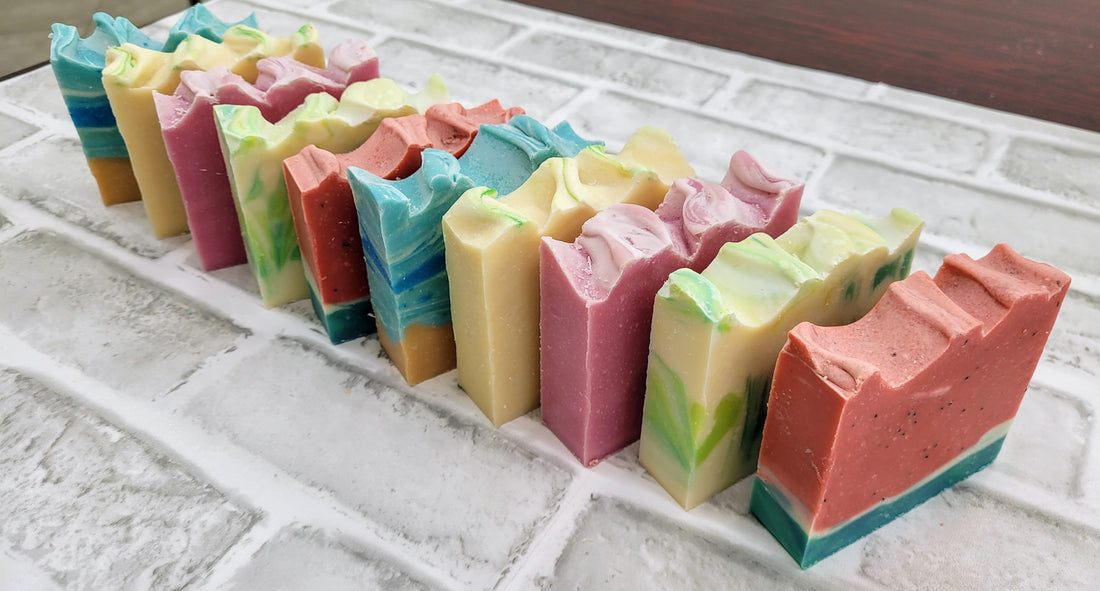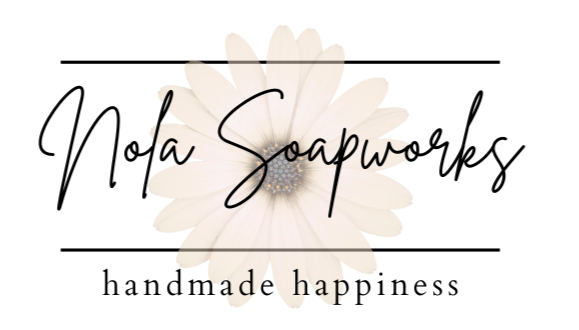
Does Handmade Soap Contain Lye?
The Short Answer: NO
I felt compelled to write about this after a craft show I participated in over the weekend. I had several people tell me they couldn't use natural soap because it contains Lye. My response to them was it does not have lye in it, however, it is listed as an ingredient because lye is required to make soap. This left them very confused.
Let's start from the beginning.
What is Lye?
Chemically, lye is Sodium Hydroxide, a caustic alkali. It can eat holes in fabric and skin and cause severe reactions with other chemicals. For soap, the crystal form of pure Sodium Hydroxide is used (this is important!) and the lye must be added to water, not the other way around.
Sounds dangerous… right?
Not so fast.
After all, table salt is made up of sodium and chloride, both dangerous on their own but edible once combined.
You Can’t Make Soap Without Lye
If you are asking the question: Do you use lye (sodium hydroxide) to make soap?
The answer is -- of course.
No lye -- No soap!
All REAL soap is made with lye (sodium hydroxide mixed with liquid).
Any skin or hair cleansing product made without sodium hydroxide is not soap, it is detergent.
If you are asking the question:
Is there lye in a bar of soap or shampoo?
The answer is "No."
The chemical reaction of making soap, called saponification, is complete, the lye and oil molecules have combined and chemically changed into soap and glycerin.
Soap by definition is an alkali mixed with fats. When combined, a process called saponification happens, creating soap. This not only allows the liquid and oils to mix (they don’t do this naturally, as you might remember from grade school science class), but also creates the action by which soap has its cleansing properties.
In other words, without Lye, you just have a bucket of chunky, fatty oils floating in water.
The important part is to make sure that the correct amount of Lye is used for the particular soap you make (more on that below) as different oils and fats require different ratios of lye.
If the soap is made properly, the lye is used up in the saponification process to turn oil into soap.
It Doesn't Say "Lye" on My Soap Bar Ingredients
If it is real soap or contains real soap, it must be made with lye!
Handmade soap bars and some Commercial "soap" bars are made with lye even though the words "sodium hydroxide" or "lye" do not appear on the labels. Soap makers don't have to include lye specifically as an ingredient if it's implied by another item. For example, sodium cocoate is the name for the substance that occurs when you mix lye with coconut oil.
Does your bar of "soap" contain ingredients such as...
- saponified oils: oils and butters are mixed with sodium hydroxide and a liquid (usually water).
- sodium cocoate: the generic name for the mixture of coconut oil with sodium hydroxide (lye).
- sodium palmate: the generic name for the mixture of palm oil with sodium hydroxide (lye).
- sodium palm kernelate: the generic name for the mixture of palm kernel oil with sodium hydroxide (lye).
- sodium tallowate: the generic name for the mixture of beef fat (tallow) with sodium hydroxide (lye).
- sodium olivate: the generic name for the mixture of olive oil with sodium hydroxide (lye).
So now that you know that ALL SOAP IS MADE FROM LYE.. let's talk a bit about what the specific oils do in soap and why they are used.
FATTY ACIDS USED IN SOAP
Each soaping oil/butter has its own fatty acid composition, and these fatty acids provide finished soap with important characteristics. The following are the most common fatty acids found in soaping oils/butters along with the qualities they provide in a finished bar of soap.
Lauric Acid: Provides hardness, cleansing, and bubbly lather.
- Coconut Oil
- Palm Kernel
- Beef Tallow
Linoleic Acid: Provides conditioning
- Almond
- Apricot
- Avocado
- Crisco
- Hemp
- Olive
Myristic Acid: Provides hardness, cleansing, and bubbly lather.
- Coconut
- Beef Tallow
Oleic Acid: Provides conditioning.
- Almond
- Apricot
- Avocado
- Coco Butter
- Crisco
- Lard
- Palm
- Shea
Palmitic Acid: Provides hardness and a creamy lather.
- Avocado
- Coco Butter
- Coconut
- Crisco
- Lard/Tallow
- Olive
Ricinoleic Acid: Provides conditioning, bubbly lather, and a creamy lather.
- Castor.. this is the only oil that produces this fatty acid.
Stearic Acid: Provides hardness and a creamy lather.
- Coco Butter
- Tallow
- Palm
- Shea Butter
Each soaping oil/butter has a unique saponification value (the number of milligrams of lye required to saponify 1 gram of the specified oil/butter). In order to create a quality bar of soap, it is necessary to find a balance between hardness, cleansing, conditioning, bubbly lather, and creamy lather.
This usually involves using a combination of oils/butters in your soap recipe. A typical bar soap recipe calls for 38% water content, and a 5% superfat (the percentage of oils that do not saponify).
Super WHATing?
Super fatting. This is when a soaper intentionally leaves oils in the soap that did not saponify.. mean.. turn to soap. This allows for the creation of a conditioning or moisturizing bar of soap.
Not all soaps are superfatted. For example.. Laundry Soaps. These contain high amounts of coconut oil, but not any extra oils. There is not a need to leave oils on your clothes.
Shampoo Bars also have a low superfat. These bars should be cleansing and not moisturizing. The purpose of a shampoo is to clean.. not leave or retain excess oils on the hair/scalp.You can always use a conditioner or vinegar rinse to soften and balance the pH afterwards.
Making soap is a craft. It is not learned in a day and is something that needs to be practiced, refined and developed.. like any skill. Aside from the base oils, there are several additives a soaper can mix in a soap to give it its unique properties.
These include :
Clays , Herbs, Botanicals, Fragrance, Purees, Seeds, Milks, Grains, Extracts, Beer ( yes BEER), Aloe, and the list goes on.. and on.. and on
Natural handmade soaps are fun ( and therapeutic) to make and most soapers welcome the opportunity to talk about their soaps , the benefits and explain their craft to you. So next time you are at a fair, festival or market.. ask questions.. just don't ask if there is Lye in the Soap.
Until Next Time
Stay Crunchy
Christine





